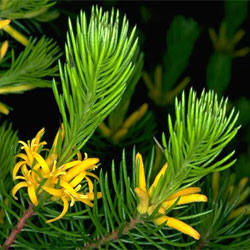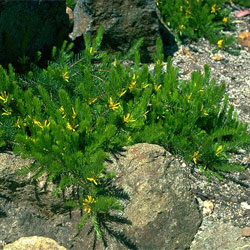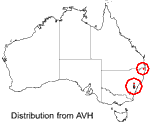Persoonia chamaepitys
 |
 |
Prostrate Geebung, Creeping Geebung
Persoonia chamaepitys belongs to the Proteaceae family; the genus Persoonia has approximately 100 species. The species of this genus can vary from small shrubs in swampy heath to large rainforest trees.
 Persoonia species are commonly known as the Geebung which was derived from the Aboriginal word Jibbong referring to the edible fruits of some of the species. Prostrate Geebung, Creeping Geebung or the Mountain Geebung are common names used for Persoonia chamaepitys .
Persoonia species are commonly known as the Geebung which was derived from the Aboriginal word Jibbong referring to the edible fruits of some of the species. Prostrate Geebung, Creeping Geebung or the Mountain Geebung are common names used for Persoonia chamaepitys .
A. B. ‘Banjo' Patterson immortalized the Geebung in his famous poem ‘The Geebung Polo Club' and butcher shops used the bright green foliage in their displays until the mid 1900s. Aborigines even used the bark of some Persoonia species to extract medicines for treating sore throats, colds and even sore eyes.
Persoonia chamaepitys is usually located in dry sclerophyll forest and heath usually on sandstone derived soils. This species distribution spreads from the Upper Goulburn Valley through the Mellong Range and Blue Mountains to the Budawang Range in central eastern NSW.
Persoonia chamaepitys is an excellent low groundcover to approximately 20 cm in height and to 1 m in width. The bright green leaves are crowded, narrow-linear 0.5-1 mm wide and up to 15 mm long. They are moderately stiff and the margins are rolled under. The leaves are generally glabrous but the new growth is light green with a light covering of soft hairs.
The bright yellow Grevillea like flowers are seen in summer and may produce a subtle fragrance. They can be from 9-18 mm long on pedicels of 1-3 mm long and are borne singly in the leaf axils close to the end of the branches forming a dense cluster. The flowers are followed by fruits, which are cream to yellowish with reddish-brown markings and 10-12 mm long. Persoonia chamaepitys can live up to 20 years.
Persoonia chamaepitys can grow in either full sun or part shade and grows well under eucalypts. It can withstand periods of dry weather but it dislikes humid or wet conditions, as this can increase the chance of leaf drop. The soil should be well drained and although a native fertilizer may help with the establishment of the young plant there is generally a low nutrient requirement.
It looks great planted in pots, rockeries, edges of retaining walls or even in hollow logs, Persoonia chamaepitys is a hardy plant and will survive well in low water conditions, great in times of water restrictions. It is a slow growing plant and is therefore perfect for low maintenance gardens.
Persoonia has long been recognized for its potential as a garden ornamental but the entire genus has proven difficult to propagate. The seed shows poor germination and is variable and even micro-propagation has proven unsuccessful. The main method of propagation is by cuttings and this still is a difficult task with poor results. Even so Persoonia chameapitys is readily available from local nurseries in south eastern Australia.
Text by Julie Cathie (2005 Student Botanical Intern)
Derivation of the name: Persoonia chamaepitysPersoonia – J.E. Smith in 1798 named the plant after Christiaan Hendrik Persoon (1761-1836), a South African botanist. chamaepitys – derived from the Greek chamai meaning ground hugging and pitys referring to its pine like foliage. |
References
ABRS (1995). Flora of Australia, Elaeagnaceae, Proteaceae 1, vol. 16. Griffen Press, NSW.
Elliot, G. (2003). 'Geebungs' so desirable in many gardens, Australian Horticulture , vol. 10, no. 5.
JCSMR (1996). Australian Plants at Floriade, [online] accessed 04/02/05, available at URL: http://jcsmr.anu.edu.au.
Ketelhohn, M., Johnston, M.E. & Gage, J. (1994) Propagation of Persoonia species by seeds and cutting, IPPS conference.
Lake, J. (1993) Persoonias for cultivation, Australian Horticulture, vol.91, no. 12.
Murray, D. (1994) Micro-propagation of Persoonia, Society of Growing Native Plants, vol.33, no.3.
Royal Botanic Gardens Sydney, Persoonia chamaepitys, [online] accessed 04/02/05, available at URL: http://www.rbgsyd.nsw.gov.au/mount_tomah_botanic_garden.
Weston P.H. (2003) Proteaceae Subfamily Persoonioideae, Australian Plants, vol. 22, no. 175, Australian Plant Society, NSW.
Wrigley J.W. & Fagg M. (1989) Banksias, Waratahs and Grevilleas and all other plants in the Australian Proteaceae family. William Collins Pty Ltd, Sydney, NSW.![An Australian Government Initiative [logo]](/images/austgovt_brown_90px.gif)

